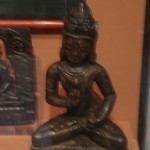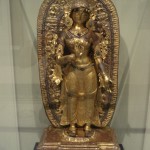Going into the trip at the Sikh Gurdwara last Thursday I was unsure of what to expect. By the time I came out I felt very positive about the experience. Things could not have been more different for me at the Hindu Mandir. From the moment I saw the Temple and noticed that there were security guards in front I had an odd feeling. This did not go away. After depositing my bag and all my valuables in the security trailer across the street I made my way into the Mandir. After depositing my shoes in a rack similar to the Gurdwara our tour guide began speaking with us about the Hindu religion. After a quick introduction he began immediately by praising Hinduism and the Mandir pointing out the intricacies of the building including the ceiling which is made from a special wood found in Burma. Unlike Mr. Singh at the Gurdwara who was dressed in traditional Sikh prayer garb our guide at the Mandir was dressed in western attire with a button-up collared shirt and slacks. After walking through the humungous prayer room my hypothesis that Hinduism and Sikhism should be polarized with one another seemed pretty accurate. The prayer room featured one giant ornate rug that covered the majority of the room. On the walls there were giant portraits depicting the past four Spiritual Guru’s of the Swaminarayan Faith and lifesize statues of each. The prayer room also featured two giant projectors in the front of the room so those that are praying in the back of the room can get a phenomenal view of the front stage. In addition there were skylights located in the center of the hall that could be opened or closed at any time.
After hearing about the prayer room we crossed over to the other side of the Mandir where we entered an exhibit explaining the ins and outs of Hinduism. Although our guide said that the Mandir served a multi-purpose role not only as a place for people to pray but also a place where people can learn, I was still a little disconcerted by the presence of a museum in the middle of a place of worship. While waiting to enter the exhibit the class looked at a wall outside that featured pictures of all the famous world politicians that had come and visited in the past. The wall also featured certificates and awards that the Mandir had won.
Inside the museum I learned a lot about Hinduism but I couldn’t help but notice the lack of humility with which the information was presented. There were quotes from notable figures such as Mark Twain and Henry David Thoreau praising the Indian way of life and the Hindu religion. An example is:
“It is already becoming clear that a chapter which had a Western beginning will have to have an Indian ending if it is not to end the self-destruction of the human race…At this supremely dangerous moment in history, the only way of salvation for mankind is the Indian way” – Dr. Arnold Toynbee (British Historian. 1889-1975).
Other parts of the exhibit not so diplomatically claimed that the Hindu’s invented the concept of zero and created the first university over 2,700 years ago. Everything seemed glorified and most definitely biased. Although I expect every museum to have some sort of bias I did not expect it to be as brutally obvious as the Mandir made it seem.
To sum up my experiences at the Sikh Gurdwara and the Hindu Mandir it is safe to say that they were vastly different from one another. Since Hinduism is the oldest living religion in the world it makes sense for them to refer to many of their ways as “Indian”. Despite this fact I couldn’t help but notice that Sikh’s were being excluded when these descriptions were being made.
The best way to describe the Hindu religion and the Baps Shri Swaminarayan Mandir is immodest. Everything both in and outside was big, new and technologically driven. Even when our class had an opportunity to participate in a traditional Hindu prayer I found it hard to concentrate because there were security guards standing around the premises. Although the Sikh Gurdwara was certainly big and looked fairly new the message preached inside was of simplicity, the polar opposite of what I sensed at the Mandir. Although I still did not feel entirely comfortable paying my respects to the guru at the Gurdwara I felt that had I participated in prayer I could have felt at peace. Even something as small as just sitting down to a meal together was significant to me. Especially since every single Gurdwara serves the same meal to every single person everywhere. To me this example completely JUXTAPOSES the Hindu tradition of hierarchy rooted in their caste system. Since Sikhism is a fairly new religion and has not fully been recognized by much of the world there are bound to be some bumps in the road but it seems to me that part of the reason Sikhism was founded in India was to rebel against the values of Hinduism.
As far as where I see these two religions going within Great Britain it is hard to say. Both Southall and Neasden seemed to be pretty homogeneous communities with mostly people of Indian descent in both regions. Because of this I think that both the Hindu and Sikh religions will have their place within London, at least for a while. Using the example of Mrs. Suri in Tarquin Hall’s Salaam Brick Lane it seems that the Indian community remains tightly knit regardless of where members of the community immigrate to. The Indian community itself traditionally churns out millions of educated “youngsters” every year many of which go on to hold prominent positions in a variety of fields including business, law and medicine. Because of this the Indian community as a whole is in no danger of disintegrating anytime soon.
As Mr. Singh told us at the Gurdwara he wishes that a day will come when he can go to the security check point at an airport and the security guard will know that he is a Sikh, therefore a peaceful man, and let him pass without any hassle. Due to the fact that Sikhism is such a young and upcoming religion (according to the BBC there are 336,000 Sikhs currently living in Britain) one can only hope that over time and with more exposure in the U.K. people will come to understand it better and the Sikh’s will find their place here in London. The only obstacle I see Sikh’s facing is their ability to blend in to the professional work force here in London. Some businesses may require that men shave off their facial hair in an attempt to look more like the typical British professional. As a Sikh one would have to ask himself how much that part of his religion means to him and whether he feels like he is sacrificing anything by shaving. If the answer is that the Sikh feels like he is sacrificing something than it will be difficult to predict what will happen.
With Hinduism being the world’s oldest living religion it is clear that Hindu’s have managed to traverse many obstacles throughout the years. In addition, they have completely modernized their religion to fit 21st century standards. Although I did not enjoy my experience at the Mandir all that much I have to admit there is certainly a rare brilliance and resilience that comes with being a Hindu. With some of the world’s smartest, most self-motivated and disciplined individuals running the show Hinduism is not going anywhere in London or in the U.K. In fact I see it growing steadily, especially with all the adaptations Hindus have made to fit the times.



3 responses so far ↓
Sikhism Pictures // Dec 7th 2009 at 04:37
Since ancient times, the spiritual land of India has displayed varied hues of culture, religion, race, language, and so on. This variety in race, culture, religion, etc., accounts for the existence of different ethnic groups who, although, live within the sanctums of one single nation, and profess different social habits and characteristics.
Sikhism Pictures // Dec 28th 2009 at 01:01
India – the land to travel to, a haven of tourism delights, a civilization to tour through. Tourists come to India for its wealth of sights, cultural enthusiasm and variety of topography and in search peace, mediation. India is where people live with variety, thrive on diversity and are too familiar with largeness to let it boggle them. Lurid luxury and limp living are inhabitants of the same lane. India holds virtually every kind of landscape imaginable. An abundance of mountain ranges and national parks provide ample opportunity for eco-tourism and trekking, and its sheer size promises something for everyone.
sikhism pictures // Jan 25th 2010 at 03:04
All the followers of the faith are requested that they should register themselves in this website providing their phone number also, so that you can benefit from the other facilities to appear in the website as this website would be kept continuously updated.
You must log in to post a comment.